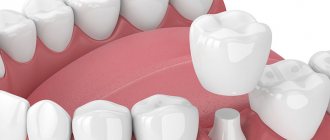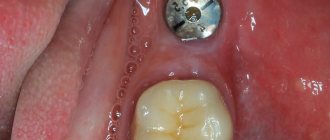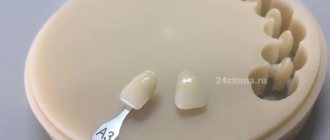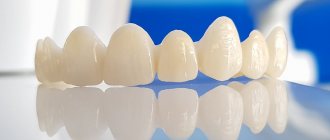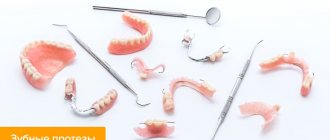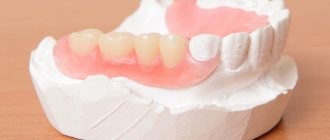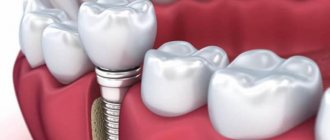Today we will talk about orthodontic structures such as temporary crowns .
We will discuss their features, types, indications for use, functional characteristics, materials from which they are made and installation steps.
We will also pay attention to the service life of these prostheses, why they are needed and much more on this topic.
Temporary crowns are a separate type of dental elements that are installed in place of a permanent crown while it is being manufactured.
The main functions of such prostheses:
- protection of the pulp from the negative influence of pathogenic microorganisms;
- preventing displacement of treated and adjacent teeth;
- formation of the gingival margin and prevention of gum growth when treating teeth with a special ledge;
- reconstruction of occlusion during therapy for increased wear of chewing elements;
- continuation of the full functionality of teeth;
- acceleration of adaptation to the modernized chewing element, which will take the place of the affected one after installation;
- maintaining the aesthetic appearance of the oral cavity.
Many people are concerned about the question: how long can temporary crowns be worn? The answer is simple - the entire period allocated for the manufacture of permanent dentures.
This may even take a couple of months. When these orthodontic structures are worn for a long time, they wear out, which will lead to the displacement of adjacent teeth.
Inflammation of the gingival margin also occurs due to bacterial contamination of the plastic. Sometimes the crown breaks, followed by gum growth and pain.
The production of such crowns is much faster than their permanent counterparts.
Regardless of what material modern crowns are made from, they are fixed with temporary cement. Such material gradually dissolves under the influence of saliva.
Sometimes it becomes necessary to attach temporary dentures after implantation. This is because it is important for the gums to return to the desired shape after this type of intervention, and non-permanent crowns can help with this.
Before installing a permanent prosthesis, the implant must take root. The average period of its integration in the upper jaw is about six months, and in the lower jaw – 4 months.
The lower jaw is better supplied with blood, and it is larger and stronger, since it bears more chewing load.
While it takes root, the patient wears a temporary crown, which imitates a regular tooth, protecting the gums from inflammation.
Dentures are placed on an implant when the dental nerve is removed and it is not possible to restore the chewing element.
The indications for the use of these structures are the broadest:
Indications for the use of crowns
- Defects of the natural crown are more than half its size;
- Increased (inappropriate for age) abrasion of teeth; correction of jaw relationship (bite);
- Deep wedge-shaped defects are areas of triangular-shaped loss of hard tissue in the neck of the tooth (near the gums), weakening it and increasing the risk of complete breakage during chewing;
- Congenital anomaly of tooth shape (for example, underdevelopment or complete absence of enamel) or acquired (for example, after injury);
- Some congenital or acquired pronounced color changes that cannot be eliminated by bleaching (discolorities) are the consequences of injuries, medications used or materials for filling root canals;
- Tilting and/or protrusion of a tooth or a group of them when the patient refuses orthodontic treatment (orthopedic “movement”);
- Combining - splinting - teeth when they are mobile (the crowns are not made separately, but as a single block and are fixed at the same time);
- The need to improve the shape and protection of the tooth during removable prosthetics (creating pronounced convex contours that will hold the fixing elements and, along with them, the prosthesis itself);
- The presence of aesthetically unsatisfactory crowns (all-metal, combined with chips of the facing material or a gray-blue border, visible at the gingival margin when it decreases or thins).
Despite the variety of clinical situations in which the use of these structures is justified, the general rule is prosthetics in the early stages.
Methods for installing temporary crowns
There are 2 most common methods of installing temporary crowns: direct and indirect.
In the first option, dentures are made directly in the patient’s mouth. Before preparing the tooth, an impression is taken from it with silicone mass.
The dentist then prepares the tooth stump, after which he inserts temporary material into the impression and places it in the oral cavity.
The temporary crown is thus obtained according to the shape of the tooth before treatment. After the material has hardened, the temporary prosthesis is processed according to the bite, polished and fixed with cement.
When using the indirect method, the dentist takes an impression of the teeth and sends it to a dental laboratory. The dental technician makes a plaster model, on which he restores the shape of the chewing element from wax, and sends this specimen back to the clinic.
During the second visit, the orthopedic dentist takes a silicone impression from the plaster model and, after preparing the tooth, makes a prosthesis.
Temporary crowns produced indirectly have some advantages: they are more reliable and durable.
From an aesthetic point of view, the greatest demands are placed on dentures that are temporarily installed on the front teeth.
Purpose
During prosthetics, the procedure of tooth preparation is carried out and temporary crowns are necessary to protect the oral cavity from unwanted and even harmful influences; in addition, such crowns allow you to maintain the aesthetics of the dentition after grinding problem teeth. It should also be taken into account that when installed on the teeth, they relieve the patient from discomfort, since ground molars lose their main functionality, and also make it possible to correctly distribute the load during implantation.
Materials for temporary crowns
The most common material used in the production of temporary crowns is plastic.
It's all about its cheapness and good color capabilities.
The plastic can be given any shade to integrate the prosthesis into the dentition without compromising the aesthetics of the smile.
However, if you wear such a crown longer than the intended time, it begins to darken. Its advantages also include ease of manufacture and installation.
Some clinics use composite materials for prostheses based on acrylic and its derivatives; they have good reviews among users.
Whatever element the dentist installs for you, it may differ in individual characteristics, since different materials have different indicators of manufacturing time, toxicity level, hardening rate, service life, ease of modeling, degree of strength and the ability to correct the shape of the structure if necessary.
Plastic temporary crowns also have their disadvantages: a pronounced porosity of the structure, due to which pathogenic microflora has every chance of penetrating deep into the material. Over time, bacteria will reach the tooth stump and cause inflammation.
As we mentioned above, this material can change its original color. Red wine, coffee, black tea and other products that have the property of staining enamel can affect the modification of dentures, and in a fairly short time.
Temporary plastic structures do not last long. The service life ranges from several weeks to two years and depends on the manufacturing conditions: in the dentist’s office or in a dental laboratory.
Based on synthetic polymers, plastic is widely used in almost all areas of medicine, not only in orthodontics. This material is able to form under the influence of heat and pressure and maintain a given shape after cooling or hardening.
This property makes it easy to work with plastic and give it the desired configuration without much effort. Plastic is divided into: thermoplastics, thermosets and gas-filled polymers.
The first option is used in dentistry. This material is characterized by low density, extremely low electrical and thermal conductivity, and not very high mechanical strength.
The cost of plastic is quite low, which directly affects the price of goods that are made from them.
How much does it cost to build a bridge?
The price for dental bridge crowns is determined by the cost category of the impressions, the design itself, installation and fitting services. There are the cheapest options available to most patients, but they will be significantly inferior to the more expensive ones in terms of operational and other characteristics.
On average, a budget bridge can be installed for 3 thousand rubles. Zirconium and metal-ceramic elements will cost 20 thousand or more, especially if implantation was performed.
The main factors on which the final installation cost depends
What affects the cost of orthopedic intervention:
- Material of manufacture. Plastic can be purchased several times cheaper than metal or ceramics. The last option with a zirconium dioxide frame is the most expensive.
- Application of implants. They can significantly increase the number of zeros on a check.
- Number of elements to install.
- Clinic location. Treatment in Moscow is much more expensive than in the regions.
- Pricing policy of a dental institution. This is due to market conditions, competitiveness, status and reputation of dentists.
Prosthetics allows you to restore lost teeth in a short time and without large material costs. When installing the structure, certain conditions must be met, and the patient must go through several successive stages. Unfortunately, despite the obvious advantages, bridges are not without their negative aspects. In addition, there are contraindications when it is not possible to restore the aesthetic appeal of a smile without harm to health in this way.
Temporary dentures for the front teeth
If the absence of lateral teeth can still go unnoticed, then the absence of at least one front tooth, especially in the upper jaw, immediately catches the eye when communicating.
Making permanent crowns takes about 10 days, so during this period the ground teeth are replaced with temporary crowns made of plastic or acrylic.
These materials are not suitable for long-term wear, as their quality is much lower than that of their permanent counterparts.
However, they do their job perfectly well for a period of 2-4 weeks. Provisional crowns, as they are also called, are needed not only to hide the defect (and the ground tooth does not look the best), but also to protect against the influence of the external environment (temperature, food plaque, acids).
Do not wear temporary crowns longer than the period specified by your doctor, as they will quickly lose their original properties.
Plastic is stained by drinks and food with coloring pigments, and pathogenic microorganisms can penetrate its porous structure and cause inflammation.
Classification:
By purpose:
- Restorative;
- Abutment (used in bridges ; they replace not only a defect within the coronal part of a tooth, but also a missing tooth or several teeth).
By design features:
- Full (cover the prepared stump from all sides), partial (three-quarter, half-crowns) leave the outer surface of the crown open;
- Telescopic (double; used in removable prosthetics, the first cone-shaped is fixed on the stump, the second, restoring the tooth, is part of the removable part and is put on the first).
According to the material used:
- Metal (noble or base alloys);
- Non-metallic (ceramics, zirconium dioxide, plastic, composite);
- Combined (metal-ceramics, metal-plastic).
By fixation method:
- Cemented (for prosthetics of natural teeth or on implants);
- Screw (used only for prosthetics on implants - artificial analogues of natural roots, strengthened inside the bone tissue of the jaws).
By service life:
- Permanent;
- Temporary - provisional (used at the stages of manufacturing the final ones to protect the stump from irritants, restore contacts with other teeth and for aesthetic purposes, including to form the contour of the gums ).
Removing temporary crowns
Temporary crowns can be removed quite easily. Over time, the cement on which they were installed becomes loose.
So, it will not be difficult for the dentist to quickly and painlessly remove it.
You can ask your treating dentist how temporary crowns are removed; he will explain this simple procedure to you in detail.
If the crown slips, you must visit the dentist to re-fix it with temporary cement. In the meantime, it is not possible to get to the dentist, it is better to return the structure to its original place.
At night and during meals, it is better to remove such an orthodontic element from the mouth. You can store it in a glass of water.
The COST of these prostheses ranges from $10-30. Their prices are low, so anyone can buy or order their installation.
Voice of the people
If we analyze the reviews of patients who resorted to installing plastic crowns, we can say that for many of them they became a real salvation. They are perfect for young girls who, due to their age, cannot yet install metal-ceramics and do not have complexes about their smile, for example, at school.
It is also noted that it is necessary to use plastic structures only on a temporary basis, since it is not possible to fit such a crown tightly onto the tooth, and it becomes a breeding ground for harmful microorganisms. Many patients say that as a temporary measure, such prostheses are almost an ideal solution to the problem, plus, their cost is quite affordable.
Care of temporary crowns
Since temporary crowns are installed only for the period of production of a permanent prosthesis, it is necessary to follow some rules for caring for them. This will help avoid its premature loss.
First, you should be careful about chewing sticky or hard foods. Secondly, it is necessary to reduce the chewing load on the entire side of the jaw where temporary crowns are installed.
You should brush your teeth in this location very carefully so as not to displace or damage the denture. When using dental floss, do not pull it out, but pull it down, holding the ends.
Then you need to release one of the ends and without force pull the remaining one in the direction away from your face. And most importantly, do not wear this orthodontic structure for longer than the intended time.
If you followed all the precautions, but nevertheless, painful sensations appeared after prosthetics, the matter is due to improper preparation for the procedure.
Incomplete cleaning of the canals, infection, root fracture, entry of a foreign object (for example, an instrument) into the root canal - all this leads to inflammation of the gums and canals of the chewing element.
In this case, you should immediately seek help from an experienced dentist.
When you wear temporary crowns, the issue of oral care is especially acute, due to the possibility of pathogenic microorganisms getting under them.
Smoking and coffee have a negative impact on the condition of teeth. An unpleasant yellow coating appears on them, as a result of which the teeth lose their beauty.
In this case, something as simple as baking soda will help. Try brushing your chewing elements with it, and you will immediately notice how much whiter they become. The beauty of teeth is not only white enamel, but also healthy gums.
Try lubricating your gums with freshly squeezed plantain juice. It also doesn’t hurt to rinse your teeth from time to time with an infusion of the leaves of the same plant - the result will become noticeable very quickly.
The most common beets also help to cope with gum problems. From time to time, take care of your teeth by rinsing them with juice squeezed from fresh beets or an infusion of its leaves.
You can also get rid of bad breath soon enough. The right toothpaste and a good toothbrush are not a guarantee of absolutely clean teeth and their radiant whiteness.
Proper teeth brushing technique is of great importance in this process. Left-handers should start brushing the chewing elements on the left side of the upper jaw, and right-handers should start on the right.
The process itself should not last less than 3 minutes. You can use wooden toothpicks to remove food debris stuck in your teeth.
But medical analogues are more suitable for these purposes, since their shape is consistent with the shape of the dental spaces. For oral hygiene, you can use an elixir to freshen your breath.
Its use in combination with other measures for the care of chewing elements can reduce the formation of plaque, tartar and periodontitis.
Do not forget to undergo preventive examinations at the dentist 2 times a year, this can identify ailments in the oral cavity at an early stage, which will help to quickly and most effectively stop them.
Restrictions on use and prohibitions
The use of temporary crowns is not always feasible and possible; there are certain restrictions on their use in such situations:
- It is not recommended to install prostheses for children under 12 years of age;
- if you are allergic to the materials used in prosthetics;
- when a patient experiences a phenomenon such as teeth grinding or bruxism;
- in cases of inflammation of the problem area of the oral cavity;
- if the patient has a deep bite;
- when identifying certain mental disorders.
For those who do not pay enough attention to oral hygiene, it is not recommended to install plastic dentures due to the fact that the porous structure of the material itself serves as a breeding ground for pathogenic bacteria.
Service life
The service life depends on the manufacturing method and the characteristics of the materials used. Thus, for those manufactured by the direct method, the service life is 1-2 months. For laboratory ones – up to 1 year. For those models whose walls are reinforced with fiberglass or metal thread, as well as those made by milling, the service life can be 1.5-2 years. But, of course, if you take good care of the prosthesis - clean it regularly and do not subject it to heavy loads.
DENTAL PROSTHESIS ON 4 IMPLANTS - from RUR 170,000.
The price includes all procedures for installing Osstem implants (South Korea), including anesthesia and diagnostics.
Hurry up to sign up for a free consultation and fix your prices.
Call now or request a call
Opening hours: 24 hours a day - seven days a week
What types of plastic are used?
Self-hardening plastics have gained great popularity in dentistry for the manufacture of temporary crowns due to their rapid hardening at room temperature. They are also capable of freezing at the temperature of the human body. This greatly simplifies the process of manufacturing temporary structures and reduces its time.
Polymerization occurs due to the initiating effect of the initiator-activator system, in which the first component is benzoyl peroxide, and the second is demethylparatoluidine.
The following types of fast-hardening cold polymerization plastics are used:
- Protacryl. It is a pink powder containing benzoyl peroxide, polymethyl methacrylate and disulfanamine. The presence of two activators allows the hardening process to reach the final result in 15-20 minutes,
- Redont. Available as a translucent pink powder and liquid,
- Stadont, powder-liquid acrylic plastic. The Stadont kit includes 3 types of powder in different colors,
- Acrylic oxide is a white plastic made from acrylic and epoxy resin. The set includes 3 powders and a liquid,
- Carboplast. It contains chalk. In dough-like form, it is distributed over the plaster model in an even layer and quickly hardens while on it.
Unlike hot-curing plastics, these types do not require heating equipment, and the size of the resulting product undergoes fewer changes. Their disadvantage is their low strength compared to hot-curing plastics.
